News
21.12.2023
NEWSLETTER
WINTER ART IN CHANGE
The history of snow and ice sculpting in competitive form spans more than 40 years. During that time, I have followed it as a competitor, judge and organizer. Has anything changed over the years? Yes, many things have changed.
For the first time, I participated in an international snow sculpture competition in Cortina d'Ampezzo, Italy in 1983. At that time, there were hardly any models and examples, or even proper tools for designing and making snow and ice sculptures. Today, and there are plenty of events and their arrangements are professional. Especially in ice sculpting, there is a wide selection of electronic sculpting tools and training for sculpting available.
I have described the development of the field in different parts of the world in the publication "SEVEN STORIES OF WINTER ART". You can read the publication HERE.
Over the years, the realization methods of the sculptures have varied and the technical level has increased. The new openings of winter art can be seen specially in commissioned works, experimental projects and the overall arrangement of winter festivals. The creation of large-scale snow and ice structures in Harbin, China and Sapporo, Japan has been automated. In 1990s, snow hotels, ice bars, winter parks and various indoor events with snow and ice structures came to winter art. Freezing and especially hardened ice projects have brought new opportunities for ice construction. Along with sculptures, we can talk about ice architecture. Large ensembles give the viewer a more versatile and comprehensive experience than individual sculptures. With lights and colors, sculptures and structures can be further enlivened if desired. The possibilities in lighting today are limitless.
I have seen the Sapporo Snow Festival, the Harbin Ice and Snow Festival, the Quebec Winter Carnival and many other winter events numerous times over the years and have judged over a hundred international sculpture competitions. I am often asked what I think was the best sculpture. A good answer to that could be: “a single snowflake”. However, they are all different too.
Juhani Lillberg 21.12.2023
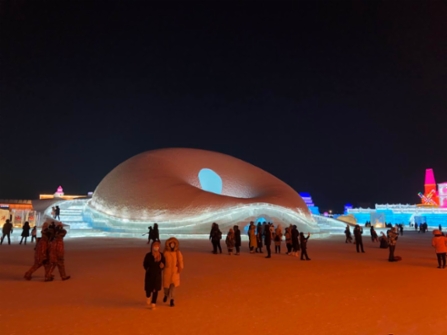
7.1.2021
NEWSLETTER 1/2021
37TH INTERNATIONAL HARBIN ICE AND SNOW FESTIVAL 2021
Most of the international Snow and ice sculpture contests have been canceled this winter due to the covid-19 pandemic. However, The 37th Harbin Ice and Snow Festival 2021 is going on and presenting stunning creations once again.
During the last couple of years the from Harbin Institute of Technology, International Ice Snow Architecture Innovation Research Center, has diversified the festival experience with some new structures made out of paper fiber composite reinforced ice, called pykrete.
By adding fibres to the ice, it is possible to create large constructions featuring unusual properties, including a relatively slow melting rate due to its low thermal conductivity, as well as a vastly improved strength and toughness compared to ordinary ice.
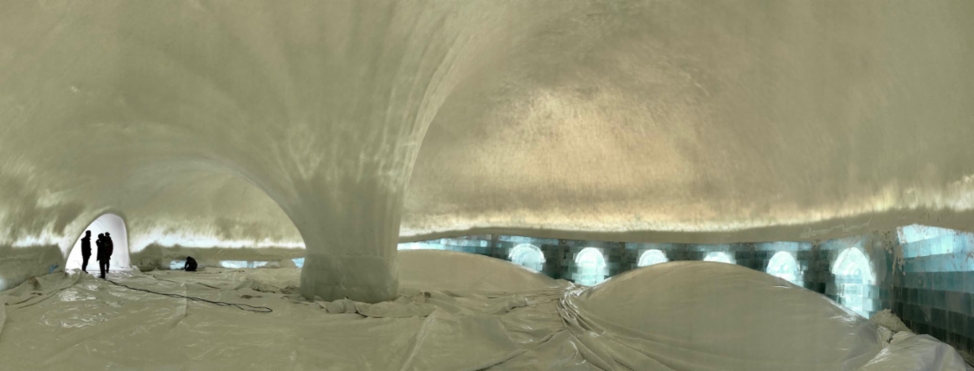
Photos: Harbin Ice and Snow Festival 2021, Professor Peng Luo, Harbin Institute of Technology.
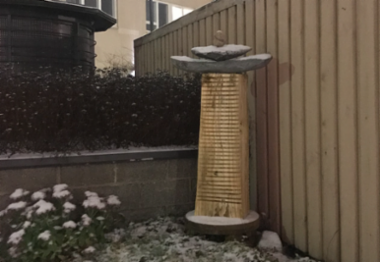
18.12.2020
NEWSLETTER 2/2020
SPECIAL YEAR 2020
Due to the covid-19 pandemic, many sculpture events for the winter period of 2020-2021 have been canceled, or limited to a smaller group of participants. Travel restrictions make it difficult to participate in international competitions and some events, as the Permian sculpture event “Zimniy Vernissage” has been changed to a national event. The Sapporo Snow Festival has announced that some of the biggest festival sculptures are not going to be produced this year. With regard to the competitions that have already been decided to be organised, it is worth following the development of the situation and the communication from the organisers.
For many artists, snow and ice has also provided a natural channel for the use of other natural materials such as wood, sand and hay. This special year with the pandemic has also activated me for wood carving and spacial art. The result is art trails and numerous garden sculptures. The most interesting new project has been a “weekly sculpture” – one sculpture that changes weekly in the yard of a historically valuable apartment building in central Jyväskylä in Central Finland. Here are some pictures of the sculptures that complement the flower plantings in the yard. More information about the exhibition can be found here.
Best wishes for a joyful holiday season and a happy New Year!
Juhani Lillberg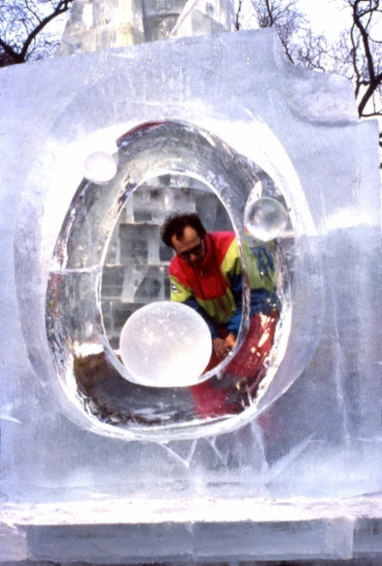
1.3.2020
NEWSLETTER 1/2020
CHANGES IN WINTER ART
Harbin Ice and Snow Festival has been for long the world's largest winter event. The event, made up of several festival venues, reported a total of 23.39 million visitors in winter 2019. The same numbers are expected to hit this year, even though there is a new competitor with a similar winter event in Changchun, northern China.
The Harbin festival runs through February and the snow and ice sculptures give the festival an important international character. I have been a foreign judge in the annual sculpture competitions and once again, my duty was to say a few words for the competitors in the closing ceremony of the competition. I noticed a good topical connection to my own sculpting career and could start my speech as follows:
“It's been exactly 30 years since I was a sculptor myself in this same event. Has anything changed in these years? Yes, many things have changed. At that time, we had not seen ice sculptures, there were no models or examples. Now you have been able to attend many events and you can get ideas and follow what's happening in the field for example through Facebook. We made our own tools. A wide range of electric sculpting tools are now available. A big change has taken place around this competition too. Thirty years ago, Harbin was a small city compared to this metropolis it is at the moment, and the festival - albeit an impressive one already then – was only a small area in the city center at Zhaolin Park”
The International Snow Sculpture Competition of the Sapporo Snow Festival was held for the 47th time this winter. I wonder if there has been changes over the decades? Well there is. I participated the competition myself as the leader of the Finnish team in 1984. The venue is still the last block of Odori Park. I have visited the festival every winter for the past 30 years. To increase the internationality of the festival, I've been trying to move the competition to a more central location in the park, but without success. At least one change in the competition has occurred. In the early days the use of support structures were allowed, fortunately no longer.
Technological development has changed the sculptures more in ice sculpting than in snow sculpting. Perhaps even too much - unnecessary trickery with the texture and the techniques is not necessary with a material that is beautiful in itself and requires clear shapes to become conceptualized. Competitions are usually public events and the sculptures should be safe and serve reasonably long time the surrounding festival as well. In the Asahikawa Ice Sculpture Competition, the durability of the sculptures was added to the criteria of judging in recent years.
I have judged more than a hundred international sculpture competition over the years. I’m often asked, what has been the best sculpture I have ever seen. The question is - of course - absurd. Things are tied to time, place and situation, and yet to so-called matter of taste. There has naturally been changes in the themes and styles due to the expansion of activities of the events and “the spirit of the times". More could happen, since especially snow as a momentary and easy material to work with could well be used in experiments ahead of the time.
The competitions have their rules limiting the freedom of the realization. The new openings of winter art are more often seen in various exhibitions and experimental events. In this website, there has previously been a story about hardened ice, which allows incredibly fine and large ice structures. Also with lights and colors, the material gets a totally new character. The areas of multiple sculptures, as winter parks and art trails give the visitor a fuller and deeper experience than individual sculptures.
Another major change in winter art is the growing amount of various kind of hotels, restaurants and other buildings made out of snow and ice. The artists are competing to be selected for decorating the hotel rooms and communal areas of the snow hotel for example on Lake Jukkasjärvi in Sweden. There are many snow hotels also in Finland, and the variety of interior spaces made from ice and snow are increasing in other counties as well. Most snow hotel decorations are reliefs, combining snow and ice. With hundreds of hotel rooms in total, we are gradually talking about an industry of snow and ice sculptures as big as with the sculpture competitions around the world.
Juhani Lillberg
President, International Association of Snow and Ice Sculpture
Photo: Harbin International Ice Sculpture Competition at Zhaolin Park in 1990
27.10.2019
NEWSLETTER 3/2019
WELCOME TO NEW SCULPTING EVENTS!
I started my winter art forty years ago. My first international contest abroad was in Cortina d’Ampezzo in 1983. Later I have continued sculpting, organized events and during these interesting years, judged over hundred international sculpting contests. Still, I am eagerly waiting for a new snow and ice sculpting season. See the list of events for this season to find out where and when we can enjoy these wonderful art forms.
Sculpting season starts in Siberia (Yakutsk and Yamal) and ends in Alaska (Fairbanks). Besides the contests many artists are decorating the snow hotels or via special projects testing new sculpting ideas. Aaron Costic from Elegant Ice Equipment has done a good work by developing the ice sculpting tools for commercial sculpting. Some others develop the lightning technique. I have had a possibility to follow the research and development work concerning the use of reinforced ice. The Eindhoven Technical University (Netherlands) and Harbin Institute of Technology (China) have done many interest projects and work continues. Many other interesting things are going on too.
One of my favorite works from last winter was no doubt the Helsinki Cathedral made of snow as a main sculpture of the Sapporo Snow Festival (Japan). The project was organized by the Hokkaido-Finland Society and made by Japanese Self Defence Forces. A specialty of my own long snow and ice sculpture career is that I have visited the Sapporo Snow Festival every year during the last thirty years. Sapporo Snow Festival has always put a lot of emphasis on the cultural exchange between countries and this time the Cathedral was symbolizing the hundred years of Diblomatic relationships between Finland and Japan.
I am happy to see, that IceAlaska have overcome the difficulties and can again offer best possible circumstances for ice sculpting. It's nice to see ice sculpting events also in warmer cities, like in Gaeta (Italy). There will also be many nice snow contests in Italy during this season. Valloire (France), Grindelwald (Switzerland) and other traditional contests will continue successfully, too. Unfortunately the new, popular event Baltic Snow Call, in Oulu (Finland) is cancelled, but everyone hope to see it again after one year break in 2021.
Harbin Ice and Snow sculpture contests (China), as parts of the biggest Winter Festival in the world, will have now an important role in snow and ice sculpting due to the coming Beijing Winter Olympic Games 2022. We have had snow and ice sculpting activities in the cultural program of the Winter Games since Calgary 1988. I hope we can continue the tradition and get snow and ice sculpture contests again to the official cultural program of the Beijing Games in 2022. In Korean Winter Games in Pyeongiang the local circumstances and sponsoring did not enable the role for winter art, but the Korean sculptors managed to have a wonderful fire sculpture event. Congratulations for the Italian artist for the decission of he Olympic Commitee to give the Winter Olympic Games 2026 to Milan and Cortina d’Ampezzo. Cortina was one of the first places to start the snow sculpting contest in the end of 1970’s and during the Turin Games 2010 we had the contests in Bardonecchia and Pragelato. It is also my devoted wish to add still the 2026 sculpting events in Italy to my long olympic experience, which started by winning the first contest in Calgary.
Juhani Lillberg
(photo: Juhani Lillberg, Sapporo Snow Festival 2019)
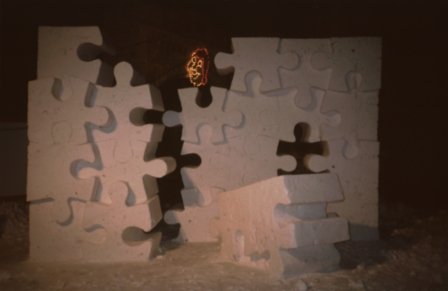
Colette Cossin, Pierre Bernard and Bernard Herquel, Quebec City, Canada 1986 (Puzzle)
23.10.2018
NEWSLETTER #2/2018
THE POPULARITY OF SNOW AND ICE SCULPTING IS GROWING
Snow and ice sculpting have undergone many changes over the decades. Snow sculpting was originally only a playful sequel to making of snowmen. When professional artists found this new interesting material, artistic snow and ice competitions started. Especially in Europe, new sculptors in the field created abstract sculptures alongside the more traditional performing sculptures. Snow sculpting became a play with lights, shadows, and surprising new ideas. This cheap, easy-to-use material made it possible to make small designs on a large scale.
Over the years, the themes and methods of snow sculpting have varied widely. The innovative development of sculpting tools has also created new interesting opportunities. Using of new technologies has affected ice sculpting even in a greater scale. Factory-made ice has made it possible to arrange sculpting events also outside the northern regions.
What is the trend of today? It will be seen when the new winter season starts in Jakutia in the beginning of December and continues until March in Krasnoyarsk and Fairbanks. Planning and marketing of many events is still ongoing, but the long list of events once again reflects the popularity of snow and ice sculpture among artists and the public.
Check out the snow and ice sculpting events of 2018–2019 HERE!
With the pictures below, you can get back to the early stages of snow and ice sculpting competitions.
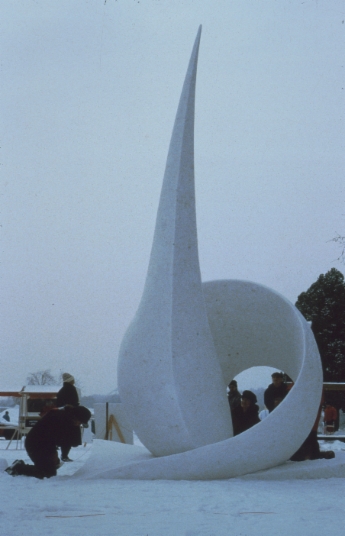
Pierre Tessier and Susanne Ricard, Rovaniemi, Finland 1986
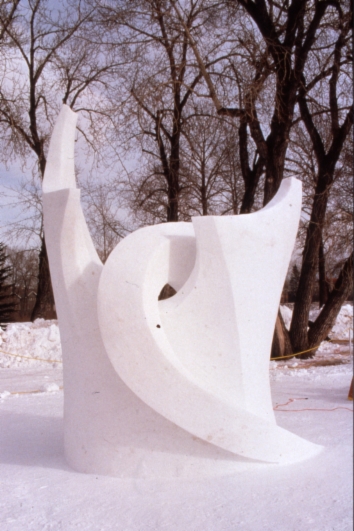
Urpo Kärri, Juhani Lillberg and Pentti Aho, Calgary, Canada
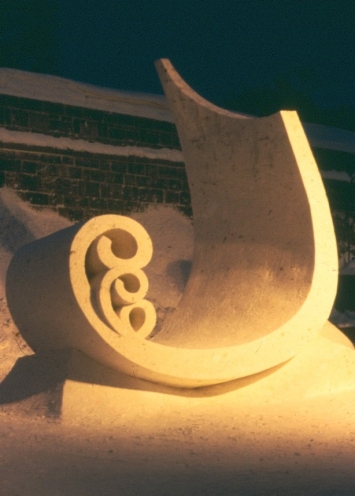
Urpo Kärri, Juhani Lillberg and Pentti Aho, Quebec City, Canada 1987
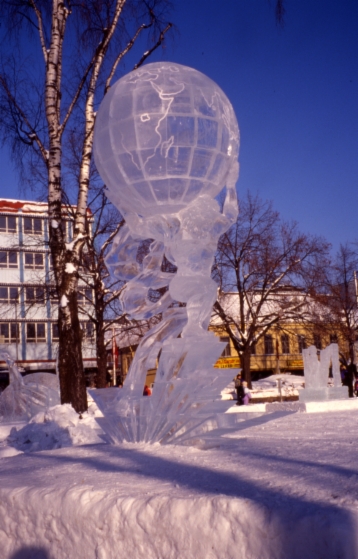
Junichi Nakamura and H.Nayaska, Hamar, Norway 1994
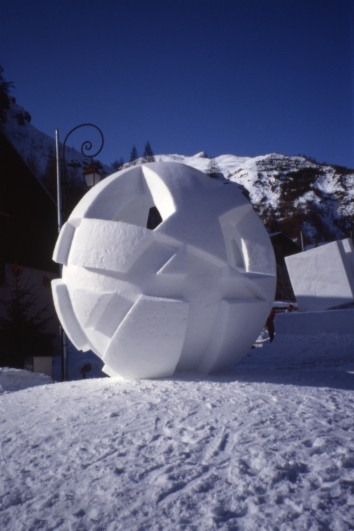
Ricky Sandberg and Dan Lestander, Valloire, France 1992
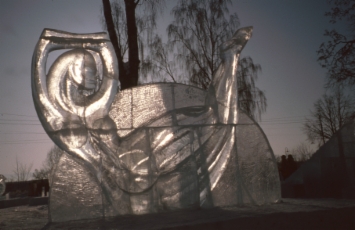
Abel Ramirez Aquillar, Valloire 1992
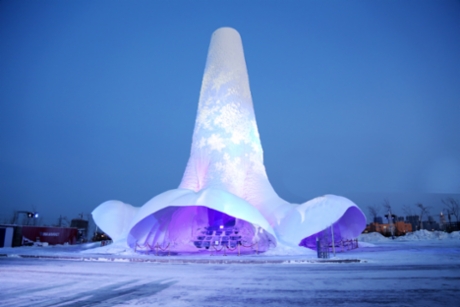
Photo by Maple Village
28.1.2018
NEWSLETTER #1/2018
NEW TYPE OF WINTER ART
Winter events are currently providing art and entertainment for millions of people around the world. Sapporo Snow Festival in Japan originally became known for its large snow constructions. This week-long event in February still attracts yearly more than two million visitors. However, the place of the largest winter event has now been taken by the Ice and Snow Festival in Harbin, northern China. Snow and ice sculpting events, architectural ice structures and outdoor events spread over the large festival area. The atmosphere of the world's leading winter city is enhanced by individual ice sculptures and smaller winter events around the city.
Over the decades, snow and ice construction has had various forms. In Finnish and Swedish Lapland, the high-quality snowhotels have been in a visible role. At the Sapporo snow festival, large-scale constructions made from snow function as a stage for concerts and other performances. At the same time, they spread the cultural awareness. In smaller winter events, the main focus is in snow and ice sculpture competitions. This winter, the International Association of Snow and Ice Sculpture has 30 international sculpture competitions in the event calendar. In Harbin, the program includes all possible structures from ice architecture to snow sculptures. In addition, the local universities have determined research and development activities, especially regarding ice construction.
One of the specialties of winter 2018 in Harbin is the "Flamenco Project" - a construction made of fiber-reinforced ice, which even gained a Guinness World Record. The name of this ice structure comes from the Spanish dress, which this beautiful 31-meter thin shell structure resembles. In previous years, Dutch students from the Eindhoven University of Technology, have realized similar projects in Juuka, Eastern Finland. The themes have been the Sagrada Familia in 2015 and the Leonardo Bridge in 2016. However, the Finnish weather did not provide sufficient conditions for this project testing new materials and forms. In Harbin, the temperatures are favourable for ice constructions and a good cooperation partner have been found from the Harbin Institute of Technology, one of the Chinese top universities.
The fiber reinforced ice is generated in this case by mixing cellulose and water. The idea is old, but partly forgotten, says the Dutch head of the project, Professor Arno Pronk. The ice becomes many times stronger, which also makes it possible to perform thin structures. The material has numerous applications in cold areas. The local project leader, architect Peng Luo, used the same technique by freezing a beautiful outdoor lecture room of 80 students at the yard of the university. There, the students will not likely fall asleep during the lecture, but the lecturer can get cold.
In
Harbin, the area was complemented by various pavilions and other frozen
constructions made by the students. The ensemble is a great example of
combining technical development, winter art and an interesting public event.
This could be used as a good example in many other places. So many winter
events have been repeated with the same pattern from year to year. Emerging
technology and new lighting opportunities provide excellent possibilities for
new experiments.
Juhani Lillberg

Photo by Qiyu
Photos of the Flamenco Tower in construction and the final result.
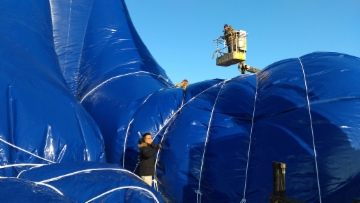
Photo by Zhaopeng
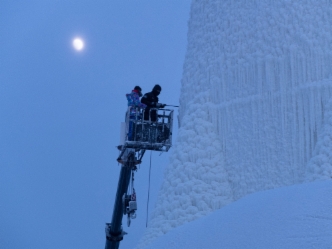
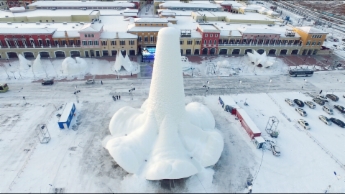
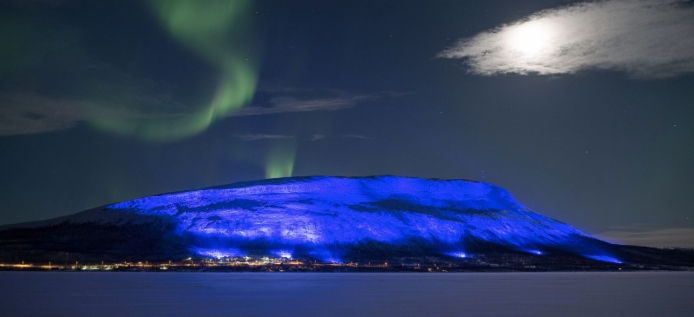
25.12.2017
NEWSLETTER #3/2017
VARIETY OF SNOW AND ICE SCULPTING
What is new during the sculpting season 2018
Snow and ice sculpting have delighted people around the world tens of years. Every year we have had more and more high quality sculpting events, special projects and individual sculptures made by order or just for own fun of artist. Some weeks ago, I was thinking that this winter slows the development. Some international contests had financing problems. We got a message that world famous ice event IceAlaska in Fairbanks is cancelled because of their last winter fire accident. It also began to look that we cannot get snow and ice sculpting contests to the cultural program of the Pyeongchang Winter Olympic Games. SkiDubai, the indoor skiing hall in Arab Emirates has many years wanted to start international sculpting event, but they also had to take one year time-out.
Now the international snow and ice contests are starting and the situation seems much better. We cannot have the Olympic sculpting contests, but those, about 30, annual international contests seem to have teams enough and everything ready for good contest. Let’s hope that global warming does not spoil the good results. There are also new events, missing from my former lists. T20 Changbai Mountains 2018 Summit in China brings together winter tourism cities and as a part of Summit there is also the 2nd International Snow Sculpture Contest in Erdaobaihe. The new event of last winter, the Cave Ice Carving Contest in Leppävirta, Eastern Finland, also has the second event in February. There also some other cities willing to start own international event and a lot of national and local contests and sculpting teaching courses like the bootcamps organized by Elegant Ice.
The great public and sponsors of events like contests. Many artists do not like contests, they want to work free of strict rules, work together with other artists, and do something new. Via internet, it has been possible to follow many interesting big ice sculpting projects during this autumn. In Elstal, Germany, 23 international artists created together spectacular ice sculptures. Another group of artists made the Gaudi’s famous Sagrada Familia as an inside ice project on Tatra Mountains, Slovakia. Some people perhaps remember the big Sagrada Familia in Juuka, Finland, made by Eindhoven Technical University, Netherlands, using hardened ice, pycrete. Italian artists have also made a big snow house to add the attraction of a Mountain Hotel. That is not all, of course there are year around indoor ice festivals in China, etc.
The most interesting ice project is going on in Harbin, China. Eindhoven Technical University continues the research on materials and forms together with Harbin Institute of Technology by freezing water with paper mass, cellulose and thus creating a 30 meters high thin, beautiful construction. The name of the project is Flamenco, the dress of Spanish woman.
When the first big snow hotels were made in Jukkasjärvi, Sweden and Kemi, Finland they were unique snow buildings with nice rooms, restaurants and other facilities giving fantastic new experiences for visitors. There are nowadays many snow hotels in Scandinavian countries and some also in Canada and Alaska. They are no more only hotels; the rooms are decorated by real art works made by artists. Tens of snow and ice sculptors are competing who can get to work in Jukkasjärvi snow hotel. These hotels and other winter activities provided by them have opened the way to huge tourism development especially in Lapland.
What is new in snow and ice sculpting and building? There is still one important thing to add, the lightning. Northern areas are not only cold, but also dark in winter time. Snow and ice love lightning. The present development of lightning gives fantastic new possibilities for snow and ice sculpting and buildings. Everyone knows that Harbin Ice and Snow World has specialized in ice lightning and Sapporo Snow Festival develops the computer aided snow lightning. In the attached picture the whole big snow covered mountain Saana in Northern Finland has got a special blue colour as a part of a Luminous Lightning Project by Kari Kola celebrating the 100 years Anniversary of Finland’s Independency.
Let’s enjoy the winter and winter art!
Juhani Lillberg
3.9.2017
NEWSLETTER #2/2017
NEW SNOW AND ICE SCULPTING SEASON 2017/2018
Yakutsk, Harbin, Valloire, Fairbanks…
Where do you want to make your snow and ice sculptures during the coming winter. It is time to make the plans and send your applications. The deadlines of some international snow and ice sculpture contests are finishing very early. Unfortunately it is still impossible to prepare the list of all international events, but you can use the old contact information for inquiries or follow the event development via internet.
What is new?
There are something new to offer during this sculpting season. SkiDubai - the indoor sking hall in Dubai, Arab Emirates – is finally starting the snow and ice sculpting event in October/November 2017. You can get more infromation via facebook (https://www.facebook.com/skidxb/?fref=ts). Another interesting thing may be the sculpting possibilities during the Olympic Winter Games in Pyeongchang in South Korea in the beginning of February. We have the long and glorious history of the olympic snow and ice sculpting starting from Calgary Games in 1988. We hope that tradition can continue in Pyeongchang, but the negotiations are still open. There are difficulties to find sponsors and local organizers for the events.
You have every opportunity to enjoy the winter!
Juhani Lillberg
Harbin 2017, Participants of Ice Contest
9.4.2017
NEWSLETTER #1/2017
SNOW AND ICE SCULPTING SEASON 2016-2017 IS OVER
Hundreds of sculptures have been again made by skillful winter artists. Sculpting season 2016-17 started in Yakutsk, Siberia in end of November and finished in Fairbanks, Alaska in the beginning of March. All the snow and ice sculpture contests were again successfully carried out in spite of some weather problems in the beginning of season. Millions of people visited winter festivals and enjoyed the winter art made as a part of them.
Harbin, Latvia team, detail of snow sculpture left: Nayoro, Snow sculpture, German team
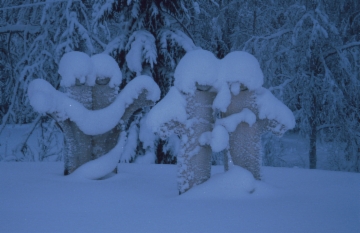
9.4.2017
ENVIRONMENTAL SNOW SCULPTING
Winter nature
Juhani Lillberg
Winter changes the nature. Winter makes things uniform. Winter makes the views in nature abstract. Winter hides something, but brings also new possibilities to the lives of people and nature.
Winter – snow and ice, cold and dark – has been during centuries considered to be negative. Later modern technology and urban living have allowed people to almost ignore the whole winter. Global climate change, ecological trends in natural science and some other things have however started to change attitude. People have begun to demand serious thinking of the world we are living in, to think
anew our relationship to nature and its resources.
Life in wintertime is not merely sleep; it can have its own kind of activity – sports, plays, art and other kind of outdoor activities. The transformative power of winter is the basis of the aesthetic richness of meaning of this season. The aesthetic potential of winter is worth remembering and putting to use. Good examples of those new possibilities are winter festivals and snow and ice
sculpting events.
Winter art – winter’s art
Winter’s art is art made by winter itself, the Mother Nature. Winter art, on the other hand, is made by man, an artist, using the materials and means offered by winter. Any art made in winter is not necessarily winter art. The defining factors are the materials (snow and ice), the methods made possible by cold weather, and, in the most traditional sense, winter as the subject of art.
Many art critics like to say that those ice and snow sculptures or buildings and other things made as parts of winter festival or international snow and ice sculpture contests are more about showing off one’s skills than art. I do not totally agree this. Competition has, of course, rules and they restrict the new ideas and variety, but we have certain rules in all human life, even in scientific research. And, it is also creativity to do something special under the certain restrictions.
The idea of snow and ice sculpting and building is however environmental. They are bringing the delights and entertainment of winter even to urban cities, teaching and activating the spectators. They are giving the artists and technicians new kind of possibilities to develop and practice their ideas. Besides they are serving as tourism attractions and financial support for local area.
Environmental winter art
Environmental art is art form that takes into account its site, materials, experiences and culture. Environmental art is a wide trend, which developed together with environmental movement and policy in the 1960’s. Term environmental art has been used quite freely and often without any tendency of environmental protection. There a lot of other similar or more specified concepts, like land art, city art, space art, community art, public art or processual art. Eco art is perhaps more specific concept, referring to works, which have ecological target and way of preparing.
Positive image of snow and ice sculptures is just based on their environmental safety. They are a part of nature’s cycles, they turn into water when melting, and become sculpting material again later. Speaking about environmental winter art starts often by showing works of Andy Goldsworthy. He used the “flow” of winter such as lifecycle of ice, snow and cold in his works. Widely shared are his pictures where the ice of a freshly frozen river has withstood the weight of a person walking on it; moments later it melted and the work disappeared. This is an example of how environmental processes form part of Goldsworthy’s works. Artist Simon Beck has later developed this idea by his massive snow and sand projects (http://snowart.gallery/).
Winter festivals and sculpting events as environmental art
Ice and snow are excellent materials for many purposes. In nature they give shelter, hinder but also help moving, effect to sound world, work as water supply, etc. Winter festivals are a good example of using those natural materials for sculpting, building, playing, and many other activities. Sculpting contests as a part of them are at same time art and art education events. They collect masses of people who do not normally visit art museums and exhibitions. People and their mental needs belong to environment, too.
Environmental art is often a process or project to which people in the area are committed. Winter festival collects different people together to prepare it. Snow and ice sculpture contests are open events where people can follow the working of artists, perhaps even be a little part of the process. A good example of big environmental winter art project was SnowShow. It was a big international exhibition of fine art and architecture in which large art installations were built from snow and ice. It took place in Northern Finland and Italy 2004-2006. It was an interesting art experiment where two art specialists from different back grounds – as world famous artist and architect - were working together and using for them new materials, snow and ice.
Sustainability of winter art
Environmental works can also have harmful influences for environment. There are doubts that big winter festivals can have also negative effects for nature in forms of wasting energy and water or spoiling the flora. Big events add also traffic problems and waste material. The effects are however local and easy to control, and not only connected to winter festivals. One negative doubt concerns the artificial, manmade snow and ice used as the sculpting and building material. Artificial snow differs from the natural snow by melting later, including more water and nutrients and of course by needing energy in producing process. There are a lot of research concerning the environmental effects of the skiing centers using much artificial snow. The negative results are mainly connected to the water reserves and partly to the erosion of the nature.
It is difficult to find negative effects from those winter festivals. If you cannot keep the festival work until they have melted it is very easy to take them away, to let them melt somewhere else. Much more important are the positive social, cultural and ecological effects of the events. Winter festivals offer for millions of people possibility to get in touch with art, culture and nature also in the urban surroundings. Art, especially art event, needs the audiences and they are in the cities. Snow and ice buildings and sculptures melt away after festival and leave only positive memories. Surely they have also positive effects for the employment, local economy and infrastructure of the hosting city.
Juhani Lillberg
18.11.2016
NEWSLETTER #2/2016
NEW SCULPTING SEASON 2016-2017
It starts again – the new season of international snow and ice sculpting.
The temperature in Yakutsk, Siberia is nighttime almost -30 degrees Celsius and everything is ready for the snow and ice sculpting events “Diamonds of Yakutia”. Contests begin on November 28th. After Yakutsk events we’ll have again about 30 international snow and ice sculpture contests.
Most event organizers have already selected the best sculptors to participate in their event. The snow and ice sculpture contests are, often as parts of the winter festivals, good entertainment for local people and very important activity in developing the winter tourism. At same time they give interesting possibilities for participating artists to test and develop their ideas and to contact other artists from different countries.
Besides the traditional sculpting contests in Quebec City, Sapporo, Ottawa, Fairbanks, Valloire etc. we have now got again a couple of new events. Luneng Resort on the beautiful Changbai Mountains in China starts own snow contest in December. Leppävirta, a small village in Eastern Finland is testing in February a new kind of indoor sculpting event in a cave. In fact there are nowadays many nice indoor ice festivals in different countries. Cities around the world are building skating and ice hockey halls and new big indoor skiing halls, too. Ice city Harbin had last summer its own summer ice festival and next year Harbin will get own indoor skiing center, biggest in the world. Ice making, sculpting and building have become year around business
Juhani Lillberg
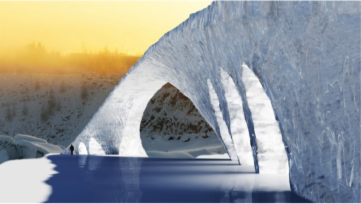
30.4.2016
A Public Event of Bridges Finland 2016, August 10, 7.30-9.00 PMSponsored by Mathematical Sciences Research Institute (MSRI)
LEONARDO’S BRIDGE IN ICE - An Attempt to Build the Longest Span Ice Bridge in the World
A Public Event Presentation by the leader architect of Structural Ice Project, Arno Pronk (University of Eindhoven), Jyväskylä-based president of the International Association of Snow and Ice Sculpture, Juhani Lillberg (University of Jyväskylä), and Nina Heikkonen, a Finnish art historian from the built heritage department of Alvar Aalto Foundation.
Ice is a well-known material, but as a building material it’s quite uncommon, even after the recently successfully realized ice-domes. After building world’s largest and the highest ice-domes, the Pykrete Dome in 2014 and the Sagrada Familia in Ice in 2015, the goal of the 2016 Structural Ice Project was to investigate how far it is possible to go with ice as a building material. The design of the ice-bridge was based on a sketch by Leonardo Da Vinci, made in 1502. The bridge was a scale model of the original drawing and had a span of 50 meters, which would have been the world’s longest span in ice ever realized…
The following Ice Bridge Events took place in Juuka, Finland
• Workshops and book presentation about Leonardo Da Vinci by Dirk Huylebrouck (KU Leuven)
• 4Dframe Experience Workshops for children and other education programs by Kristóf Fenyvesi (University of Jyväskylä - Bridges Organization – Experience Workshop), Osmo Pekonen (JYU) and Jouko Koskinen (Aalto University). Details: (http://www.elmenymuhely.hu/?p=3232&lang=en)
• Structural Ice Symposium on 12 February, 2016 (www.fabricforming.org)
Snow and ice sculpting season 2016 is over. We had again about 30 international contests and some special projects. They got a lot of publicity. Via internet it has been possible to follow those events online or at least to see the finished works. Artists has been eager to tell about their working and to show pictures in Facebook, too.
I myself visited and judged some contests, and had lectures on snow and ice sculpting and festivals. In Harbin I had a chance to speak in Cold Zone Forum for prestigious audience about new things and ideas of developing the winter art and festivals. Using much pictures I spoke about new technical and lightning possibilities, special projects, and using of indoor facilities, like the indoor skiing halls, for sculpting. Harbin is also building new skiing hall, the biggest in the world, to be opened next year.
It is now time for sand, wood and stone sculpting events. Valloire in France is also besides of those organizing again hey and straw sculpting contest. At same time we have to prepare for snow and ice sculpting contests 2017.
Juhani Lillberg
(Photo: Harbin 2016, Juhani Lillberg)
Lillberg, Juhani
Best winter cities, Harbin, Sapporo, Quebec City or Fairbanks?
Certain places are famous for winter sports, but all these four are known for their magnificent winter events. The worlds oldest consciously organized winter festival is perhaps the Quebec Winter Carnival in Canada, but also the Sapporo Snow Festival on Hokkaido, Japan, came to public notice with its big snow buildings over 60 years ago.
Today, however, the most massive winter event is clearly the Harbin Ice and Snow Festival. Winter festivals are a way to create a winter image for a town, and at the same time to show willingness to enjoy the winter and to utilize it to bring joy to local residents, as well as to advance tourism. Plenty of smaller villages and towns have their own winter events which, of course, don’t attract millions of visitors as Harbin and Sapporo do. However, they are interesting, and essential at least for the local population. They break up the harsh winter, and make people go out to make the winter environment beautiful and pleasant together.
A good winter town is a good summer town, too. Snow and ice are the central building materials of a winter festival. They are used for decorating the environment, for play and hobbies, and also more and more for winter art purposes. In addition to local sculpting events, about thirty international snow or ice sculpting contests are organized yearly around the world, either as a central part of a winter event or as a separate art event. The above mentioned winter festivals have become known around the world mainly for their big snow and ice constructions.
Throughout the years, the residents of Sapporo have seen numerous public buildings of the world made of snow in the middle of their city. As to Harbin, huge entities are built of ice. It is difficult to illustrate the situation by numbers, but just one of last year’s festival sites in Harbin used 180 000 tons of natural ice, and almost the same amount of snow for its constructions. Add to this a skillful use of lighting; you get a utopian environment, a huge demonstration of collaboration and skill.
Uniqueness of snow and ice sculpting
Many may wonder whether all this makes any sense, to make something that melts away. Yes, it does. Although the festivals last only for some weeks because of the warm conditions, it brings rhythm to people’s lives and offers a variety of culture, entertainment, being together, and also culinary enjoyment at the venue. Also other things in life are momentary. Take a sports event or a concert – all that remains, is a potential recording.
For artists, snow and ice are enormously interesting materials. Both are easy to work with, and make also big sculptures possible. As sculpting material, they are unique. Many sculptors see poetically, how the sculpture is a part of nature’s cycles when it turns into water when melting, and becomes sculpting material again later. Snow, pure white as it is, requires clear shapes, uniting light and shadows. Transparent ice refracts light beautifully, is an expression of eternity, it tells about the humbleness of man in front of the nature. When water freezes, time seems to stop, and goes on when ice melts. Being a bit poetic makes life richer and more interesting.
Developing of snow and ice activities
Big winter festivals and sculpting events start yearly in Harbin in January, and end in March in Fairbanks, Alaska, where the circumstances enable making of the best possible natural ice. The amount of winter festivals and sculpting events has grown up all time and especially in recent years all festival organizer have tried purposefully develop their events. Countless special projects form a group of their own in development work.
In Scandinavia there are many big snow castles, including snow hotels, restaurants, chapels and other facilities. The first and perhaps still the best snow hotel has been in Jukkasjärvi, near Kiruna town in Sweden. The hotel had last winter 60 nicely decorated hotel rooms and the techniques of ice harvesting and building is very effective. There have been works of sculpture at the North Pole, on the top of the Alps, on Caribbean luxury cruisers, etc. Each luxury restaurant has its own skillful ice sculptor decorating the dinner table or ice bar of the restaurant.
Many works of art have been custom-made and many have been made as exhibition projects: for example the SnowShow in Rovaniemi and in Kemi in Finland some years ago, and later as a follow-up project at the Winter Olympics in Torino. Eindhoven Technical University in Holland has as a part of research of building materials tested pykrete, the hardened ice. Together with Finnish universities and companies they have built by using pykrete in Finland Quinnes record ice dome and huge Sagrada Familia Temple from Barcelona, Spain. The 2016 project will be Leonardo da Vinci’s bridge and Mexican architect Felix Candelas unique pavilion building.
Ice sculpting is no more only the activity of northern, cold areas. More and more ice events have been made inside buildings around the world. Indoor skiing halls in Dubai and elsewhere want to have ice sculptures. In Europe there have been big indoor ice sculpting exhibitions in Belgium, Poland, etc. Development of ice and snow sculpting has been possible because of new technology. We have new kind of machines for ice harvesting, cutting and lifting. When the artists 30 years ago started to sculpture snow and ice they had very simple hand-made tools. Developing and selling the electric ice sculpting tools is nowadays a growing business.
Above all, winter festivals are spectator events during the cold and dark winter. Snow and ice are unique materials for creating beautiful festival surroundings, but as we know with lights the experience of spectators can be multiplied. Along with the development of working tools the development of lightning (especially LED-lights) and information technology have opened huge new possibilities for winter festivals. Snow, ice and lights belong together as we can see here in this wonderful Harbin ice and snow festival.
